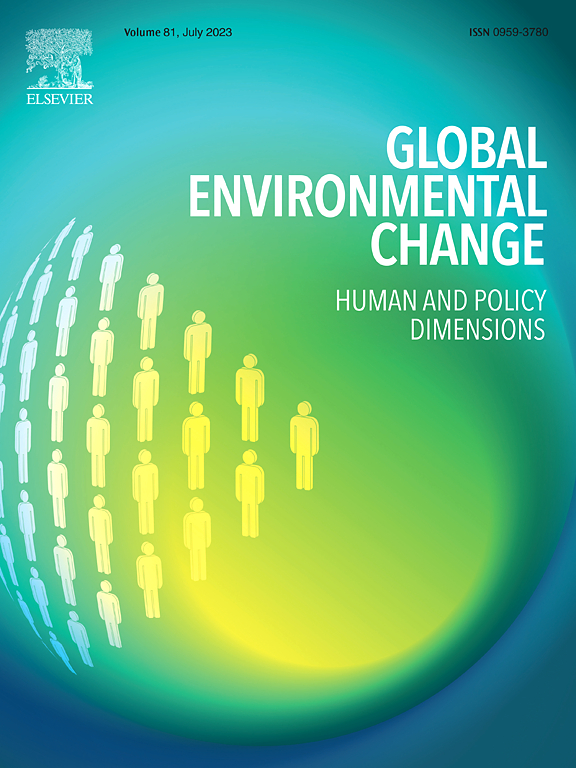Attributing deforestation-driven biodiversity decline in the Gran Chaco to agricultural commodity supply chains
IF 9.1
1区 环境科学与生态学
Q1 ENVIRONMENTAL SCIENCES
引用次数: 0
Abstract
Agricultural expansion is one of the principal drivers of biodiversity loss globally. Attributing biodiversity loss to domestically consumed versus internationally traded agricultural production is vital to make supply chains more transparent and sustainable. However, such an attribution is challenging due to the complexity of agricultural supply chains and the lack of tools and data. Here, we attributed biodiversity decline in the Gran Chaco, specifically the Argentinian and Paraguayan Chaco, to both soy and beef agricultural commodities and the domestic and foreign demand for these. We integrated three sources of multitemporal data at a subnational scale (data on mammal diversity, land use change and commodity trade) to first differentiate pasture- versus cropland-driven biodiversity decline and second, to assess the share of the decline associated with domestically consumed and internationally traded Argentinian and Paraguayan soy and Paraguayan beef. In doing so, we provided four novel insights. First, pasture expansion had a greater relative biodiversity impact than cropland expansion. Second, the biodiversity decline associated with domestic and international consumption depended on both the quantity of imports and the precise location of production and sourcing. Third, domestic consumption of commodities in Argentina and Paraguay was associated with a much greater risk of driving decline in biodiversity than agricultural exports from these nations. Fourth, considering only one facet of biodiversity risks underestimating the decline in biodiversity linked to agricultural expansion and commodity supply chains. By connecting agriculturally driven biodiversity decline in the Gran Chaco to commodity supply chains, we highlight the importance of increasing the transparency of supply chains to make them more sustainable. Doing so will be critical to prevent further biodiversity loss in not only the Gran Chaco but also the other dry forests of the world.
将大查科地区森林砍伐导致的生物多样性下降归咎于农产品供应链
农业扩张是全球生物多样性丧失的主要驱动因素之一。将生物多样性损失归因于国内消费而非国际贸易的农业生产,对于提高供应链的透明度和可持续性至关重要。然而,由于农业供应链的复杂性以及缺乏工具和数据,这种归因是具有挑战性的。在这里,我们将大查科,特别是阿根廷和巴拉圭查科的生物多样性下降归因于大豆和牛肉农产品以及国内外对这些农产品的需求。我们整合了次国家规模的三个多时段数据来源(哺乳动物多样性、土地利用变化和商品贸易数据),首先区分牧场和农田驱动的生物多样性下降,其次评估国内消费和国际贸易的阿根廷和巴拉圭大豆和巴拉圭牛肉的下降份额。在此过程中,我们提供了四个新颖的见解。首先,草场扩张对生物多样性的相对影响大于耕地扩张。其次,与国内和国际消费相关的生物多样性下降取决于进口量和生产和采购的确切地点。第三,阿根廷和巴拉圭的国内商品消费与导致生物多样性下降的风险比这些国家的农产品出口大得多。第四,只考虑生物多样性风险的一个方面,低估了与农业扩张和商品供应链相关的生物多样性下降。通过将大查科地区农业驱动的生物多样性下降与商品供应链联系起来,我们强调了提高供应链透明度以使其更具可持续性的重要性。这样做不仅对防止大查科森林的生物多样性进一步丧失,而且对防止世界上其他干旱森林的生物多样性进一步丧失至关重要。
本文章由计算机程序翻译,如有差异,请以英文原文为准。
求助全文
约1分钟内获得全文
求助全文
来源期刊

Global Environmental Change
环境科学-环境科学
CiteScore
18.20
自引率
2.20%
发文量
146
审稿时长
12 months
期刊介绍:
Global Environmental Change is a prestigious international journal that publishes articles of high quality, both theoretically and empirically rigorous. The journal aims to contribute to the understanding of global environmental change from the perspectives of human and policy dimensions. Specifically, it considers global environmental change as the result of processes occurring at the local level, but with wide-ranging impacts on various spatial, temporal, and socio-political scales.
In terms of content, the journal seeks articles with a strong social science component. This includes research that examines the societal drivers and consequences of environmental change, as well as social and policy processes that aim to address these challenges. While the journal covers a broad range of topics, including biodiversity and ecosystem services, climate, coasts, food systems, land use and land cover, oceans, urban areas, and water resources, it also welcomes contributions that investigate the drivers, consequences, and management of other areas affected by environmental change.
Overall, Global Environmental Change encourages research that deepens our understanding of the complex interactions between human activities and the environment, with the goal of informing policy and decision-making.
 求助内容:
求助内容: 应助结果提醒方式:
应助结果提醒方式:


